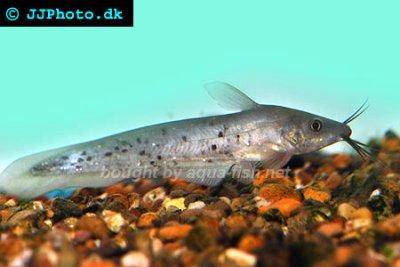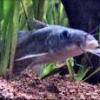Narrowfront tandan - Neosilurus ater
Scientific name: Neosilurus ater
Common name: Narrowfront tandan
Family: Plotosidae
Usual size in fish tanks: 45 - 50 cm (17.72 - 19.69 inch)
014
Recommended pH range: 6.2 - 7
Recommended water hardness: 6 - 13°N (107.14 - 232.14ppm)
0°C 32°F30°C 86°F
Recommended temperature range: 24 - 27 °C (75.2 - 80.6°F)
The way how these fish reproduce: Spawning
Where the species comes from: Oceania
Temperament to its own species: peaceful
Temperament toward other fish species: aggressive to smaller
Usual place in the tank: Bottom levels
Short description
The Narrowfront tandan (Neosilurus ater) is a large Australian/New Guinean eel-tailed catfish (family Plotosidae) reaching 45–50 cm in aquaria. It is hardy but predatory: calm by day and active at dusk/night, it will eat fish small enough to fit in its mouth. Best kept as a single specimen (or a small group only in very large tanks) with robust tank mates of appropriate size. Handle with extreme care: the dorsal and pectoral fin spines are venomous.
Origin
Oceania – freshwater rivers, billabongs and floodplain lagoons of northern Australia and parts of southern New Guinea. Habitats are warm, often turbid waters with soft bottoms and submerged wood.
Food and feeding
A carnivorous benthic forager. Offer sinking carnivore pellets/sticks as the staple, plus meaty items such as prawns/shrimp, fish pieces, mussel, bloodworms and mysis. Feed mainly at lights-out so the tandan can forage without competition. Avoid routine feeder fish (parasites/poor nutrition).
Sexing
No reliable external differences; females may appear deeper-bodied when ripe. Venting is required for certainty.
Breeding
No confirmed home-aquarium spawnings are documented. In nature, reproduction is seasonal; details in captivity are scarce.
Lifespan
Typically 8–12 years with strong filtration and stable warm water.
Behavior & compatibility
Generally non-belligerent toward similarly sized fishes, but will prey on smaller tank mates. Keep singly or, if space allows, as a small group with ample hides to reduce pecking order disputes. Suitable companions include large rainbows, robust cichlids of similar size, and armored catfishes that are too big to swallow. Avoid nippy species that target whiskers/fins.
Tank requirements
- Tank size: large footprint; think 500 L for an adult, substantially more for groups.
- Substrate & scape: fine sand or smooth gravel with driftwood roots and broad caves/tubes for daytime shelter.
- Water: pH 6.2–7.0 (slightly acidic to neutral), soft to moderately hard; temperature 24–27 °C is a good target.
- Flow & filtration: moderate flow with robust bio-mechanical filtration; maintain low nitrate via regular large water changes.
- Lighting: subdued; dusk/dim feeding encourages natural behavior.
Care notes
Venomous spines: the dorsal and pectoral spines can inflict painful stings. Use rigid containers for transfers instead of nets, and never pin the fish against hard surfaces.
Neosilurus ater has venomous dorsal and pectoral spines. Use a lidded container for net-free capture and keep hands clear of the spine bases during maintenance.
Pictures
Bought by aqua-fish.net from jjphoto.dk.








 Dewfish
Dewfish